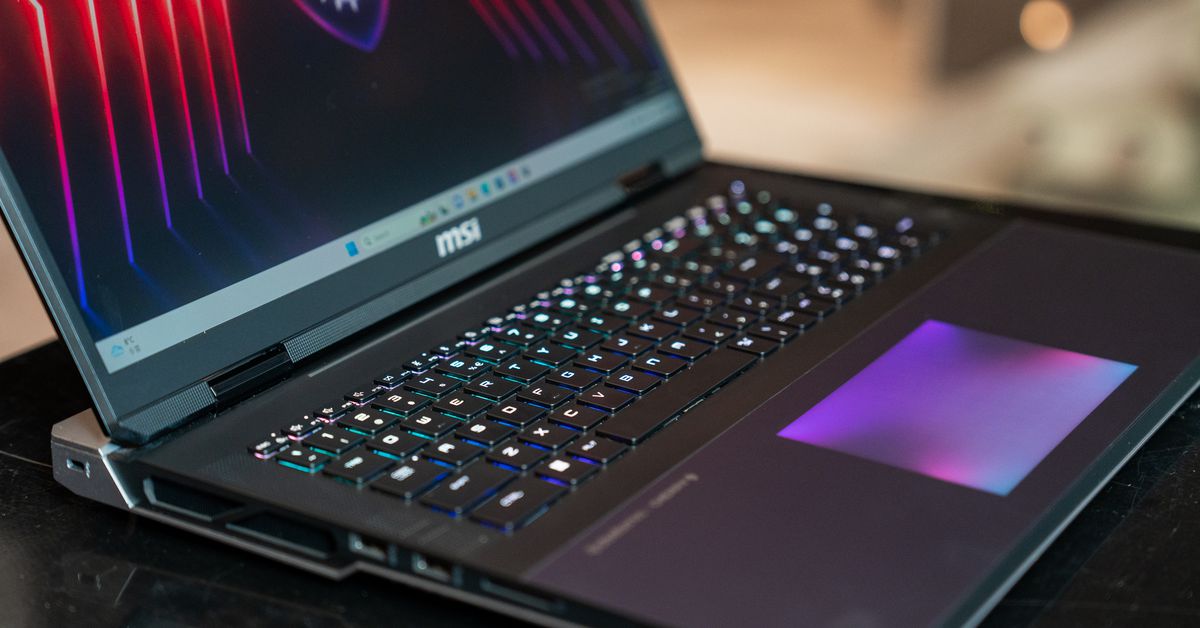- cross-posted to:
- hackernews@derp.foo
- cross-posted to:
- hackernews@derp.foo
What a weird title. They are completely 2 different, independent things. Just to be categorized with AI hype articles…
The missing context is that this article is part of their CES coverage. At the expo the huge theme was everyone putting AI in every fucking device they could. A subtler theme that didn’t get as much attention was a bunch of new devices launched with Wifi 7 for the first time. So the headline was what was happening at the expo.
Also, one of these is a mere update hugging the tech plateau, the other is a disruptive hockey stick.
All news are for investors nowadays. Microinvestment runs the 2020s world.
I guess one reason why no one is paying attention to it is because is the Wi-Fi speed usually the limiting factor? In my case I’ve rarely ever maxed out my Wi-Fi 6 speeds. Typically the host or the network that I’m on that is the limiting factor.
Although I’m also in the US so I know where not know for having the fastest internet in the world. Maybe in other areas of the world WiFi 7 might be more useful.
Canada, one of our primary ISPs offers fibre to the home with speeds of 1Gbit and even higher. So many threads on their forums with users confused why they can’t get anywhere close to 1Gbit and it always turns out to be WiFi.
I can get very close to 1 Gbit on Ethernet but top out at maybe 400 Mbps on wifi.
Exactly, wifi 7 will probably get us to or close to practical 1Gbit wireless speed vs theoretical 1Gbit speeds.
Wifi 6E already does that, I get about 940 Mbps with my phone on my 6GHz network. That is maybe 10 Mbps less than I get wired.
If you have a non-congested area, 6e is just as fast as 7. 7 just brings a wider channel width and the ability to hop between 6ghz and 5ghz.
I think we are quite a long time from 6E becoming congested. The equpiment is just too expensive right now (nevermind the price of Wifi 7 equipment). In my pretty densely populated area I have zero other 6GHz networks visible from my place.
There were so few 6E devices released, particularly consumer level ones that we can sort of just “skip” it when talking about home user Wifi issues.
I don’t think we’ll ever hit 6ghz congestion because it just doesn’t go very far.
In downtown areas 2.4ghz wifi is basically useless, but 5ghz is still pretty serviceable thanks to it’s lower range and more channels. 6ghz is just another 2.4 to 5ghz jump, but now we’re getting down to single room levels of range.
I wonder about ping. Will it ever be on par with Ethernet for online gaming?
Single channel WiFi probably is unlikely to get to sub millisecond response timesas it is shared air time for both send and receive of all devices, wifi 7 multi link might help if it can route some traffic on different channels but over all I never expect it to get close to what wired Ethernet can do.
However, for the majority of people (basically exclude professional gaming) below 10ms will be perfectly fine and not noticeable at all, the importance of 6E wasn’t it’s speed but it’s improvement on more consistent connections, if WiFi 7 can improve on this, it’s a benefit to gamers and worth upgrading.
This is very useful in places like big city where there are gazillion of devices fighting for airtime. Wifi 7 devices can dynamically switch channel, or even use multiple channels at once which should help a lot in congested environment.
I have one WiFi 6 access point and unless I’m running a benchmark while right next to it, I can’t tell the difference between it and the WiFi 5 access points. I doubt WiFi 7 will make much difference unless you are running 320MHz channels. There’s only enough bandwidth for 3 of them, so good luck getting decent performance unless you live out in the country though.
High speeds are helpful for anyone that has network storage and doesn’t want to plug in an ethernet cable. It doesn’t have anything to do with how fast your internet is.
They’re is so much wrong here I don’t know where to start.
-
get a better wifi 6ap. You should be getting about 2x the bandwidth. I get about 900mbps on my 5 year old cell phone sitting on the couch.
-
Wi-Fi 7 smaller width channels to avoid interference. Pretty much everything you’ve said here is backwards/wrong and i encourage you to do some learning on your own.
I’m using a Unifi U6-Lite access point and an Intel AX210 WiFi card on an 80MHz channel. Iperf showed about 600mbps down on WiFi 6 and 550 on WiFi 5 from across the room last time I tested it. There’s no other WiFi networks anywhere near me to interfere with anything.
Smaller channels will avoid interference, but you get less bandwidth on them. The bitrate only increased 20% between WiFi 6 and 7. To get a large speed boost, you need the wider channels that WiFi 7 supports.
The lite, being the cheapest model in that line, unsurprisingly only supports 2x2 mimo. Getting 600mbps from that is actually really good, but given net bandwidth is nearly identical to what is available for wifi5 I’m not surprised you didn’t see much of a difference.
An ap with 4x4 mimo would substantially outpace your wifi 5 router.
The AX210 only supports 2x2 MIMO and I haven’t seen any WiFi 6 cards with more streams than that.
An AP with 4x4 MIMO would provide more bandwidth for multiple clients since WiFi 6 supports MU-MIMO in both directions.
On my Archer BE800 and AX201 equipped Thinkpad T14 I’m able to hit just over gigabit on speed tests. Your wifi 6 lite is only 2.4 and 5ghz which is probably why your speeds are so poor, especially if you have other devices on the network.
Unifis wifi 6 offerings were really disappointing. 2.4 5ghz wifi 6 only is just kinda stupid, and I think that’s why it has had such lame reception (no pun intended). Wifi 6 with 6ghz is incredible. Wifi 6 on 5ghz is good. And wifi 6 on 2.4ghz is just kinda awful. It’s not worse than anything previously on 2.4ghz, but it’s just not a step up.
-
I’m more excited about reducing congestion when more of my neighbors upgrade to 6, so that BSS coloring and other wifi 6/7 features can enable more efficient use of the spectrum. Before wifi 6 most of the upgrades were just increasing data rates, but really lacking in improvements to spectral use efficiency (like the resource unit allocation in OFDMA which splits channels into sub carriers and centrally plans assignment to multiple client devices for simultaneous use which results in much less wasted airtime compared to each device yelling and listening while waiting to see if they can have exclusive access to the whole channel which wastes time) and interference management (like preamble puncturing which allows partial use of a channel when only a portion has interference). In a crowded environment like an apartment building wifi 6 should help a lot in reducing channel utilization.
I guess one reason why no one is paying attention to it is because is the Wi-Fi speed usually the limiting factor?
On a LAN? Pretty easily if you have a gigabit or greater network. Wi-Fi 6 can do close to gigabit but not consistently and needs to be close to an AP, and it’s unlikely a bunch of devices using it at the same time will be able to do maintain that peak. Maybe 6E, although I don’t have any devices myself that support it.
And WAN speeds of gigabit and greater have become more common, too.
And this ignores the improvements in latency with Wi-Fi 7, which is definitely an issue with traditional Wi-Fi.
Also the fact that the faster the wifi, the easier it is to block.
These new standards aren’t really targeting residential use so just people shouldn’t care.
Ok, I know why we changed the version naming scheme: a, b, g, n, ac, ax… It was a nightmare, just awful.
But I’ll bet it does still have a IEEE designation, so how does 6 or 7 map to the previous scheme? Also, what’s new, what are the impressive current speeds and features?
WiFi 7 = 802.11be, FYI
5 is AC, 6 is AX
Removed by mod
The article is about how new products are getting support for Wifi 7, so probably none of your current devices.
Removed by mod
That’s basically CES in a nutshell. Nearly everything shown off won’t be useful for years.
The headline seems to be targeted at dedicated Verge readers who know that AI is the current big buzzword at CES, they are likely a bit tired of it, and are interested in something that’s not AI.
My laptop only supports 2.4 GHz lol
The WiFi card in laptops tend to be modular so you may be able to upgrade it. I’ve never done it though so dunno
Used to be but it’s been part of the chipset for years now. You can add a USB dongle though
Mine’s a 2021 Dell Inspiron 15 7510, but its a 15.6 inch, might be different in smaller form factors
A lot of laptops still have socketed wireless. Intel even sells wifi 7 m.2 cards (using real pcie, not cnvio) for exactly this purpose
Yeah, I just upgraded to a new laptop 18 months ago, it does WiFi 6 I think, the one that’s popular for the Quest 2 headset anyway, and this is going to be my computer now for at least another 8 years, like the last one was.
Same with the router, which I upgraded to get that newer WiFi, and now it’s going to sit there doing it’s job for probably the next decade, because it does it well.
Maybe in 2032 I’ll upgrade to WiFi 7, but there’s no real need to do so until then, unless something really important that WiFi 6 can’t handle comes along.
What an absurd headline.
EDIT: And “AI” was only mentioned a single time in the article.
The biggest names in laptops showed up to CES this week with new designs, new chips, and usually some way to sneak in the term “AI.”
The biggest names in tech reporting apparently showed up to the internet this week with some way to sneak the term “AI” into their headlines. Fuck you, Wes Davis.
Also how exactly was it quiet when several major YouTubers covered it? Fucking hate these bogus clickbait headlines
PowerShell 7 quietly took off while I was struggling with my IBS.
Get-Money | Buy-SomethingUseful | ?{$_.item -ne “WiFi 7”}
See ya in 5 years when ISPs will start providing WiFi 7 enabled routers
Why would you use your ISPs router? Mine is set to modem mode an do have my own router which is far better quality and also totally under my control security wise.
Because most of the time they don’t let you, or make it super difficult to set up
Additionally, most end users aren’t tech savvy and just use whatever was given by the ISP
I dunno, we plugged ours into the other modem and it worked immediately
Key words: “most of the time”. There are exceptions to this obviously
deleted by creator
Yeah, no one’s talking about wifi 7 because it’s not even close to taking off yet.
Google fiber and any other ISP that offers 1gbit or greater speeds are already giving with 6 routers, and 7 is soon to follow. Wifi 7 is already planned for Google Fiber and I know others have it on the way. Basically any ISP offering >1gbit speeds is going to have a wifi 7 router soon.
https://fiber.google.com/blog/2023/10/gfiber-labs-announces-first-project-20.html
And when did decent mesh systems start costing $1K+?!?!
I used to scoff at people who would say “just get an access point”, but after looking at too many mesh systems last years with their ridiculous prices, I went with couple of access point and I do not regret it.
Stares at my home networking stack.
Oh I know… I get leftovers from work for my home lab. But enterprise WiFi will never be a thing you’d need in a DC. 48 port 10GbE Cisco switches is another story 🙂
Of course they sound like a jet engine …
Lucky you not having jets fly over your place in DC, unless your in Glover Park/Georgetown then you get to hear the planes going to National at 7 am
It feels like the rollout of client modules and APs/routers was better synchronized this time. Back with wifi 6 I ordered the Intel modules within a week of them being available on AliExpress and then waited for what felt like months for APs to be available (it looks like unifi’s wifi 6 ap finally came out in November 2021 based on when I bought it). Unifi’s U7 pro dropped a few days ago so I nabbed one as soon as I saw the email and that arrived today so that’s already set up, and the wifi 7 modules have already been out for a bit, i just didn’t order them since I was anticipating a wait for APs. So now I just gotta wait a bit for shipping and I’ll have all my laptops upgraded too.
as a poor pc gamer runnin a 6700k i will see yall soon because this thing is getting crusty
My gaming PC doesn’t even have wifi, I just ran a cable. I wire everything I can, even my Chromecast using USB otg adapters. The less stuff that’s on the WiFi, the less crappy of an experience the stuff that’s left will have. Also I’m just about there with you, my non-work laptop is an almost 6 year old XPS 15 with a 7700k, but I swapped the wifi chip for an ax200ngw wifi 6 one for $15.
On the cable point, the more interesting network advancement is 2.5GbE finally becoming wildly available, with switches, USB dongles, pci-e cards, and routers finally using them, and for prices that are only marginally more expensive then gigabit. And cheap enough that even used SFP+ gear looks expensive enough to not be worth the hassle, particularly as they can eat power in various ways.
can the wifi teams finally allow bluetooth to copy their homework? 😂 they’re still at 2mb/s roundabouts
Bluetooth has completely different design and goals. When it came out it wanted to do notifications. Nowadays it’s been shoehorned into lots of things it wasn’t originally supposed to do, like media streaming, controllers, file transfer etc. That’s a limit to how far the spec can be twisted.
I think you’re confusing BLE and Classic Bluetooth here. Classic Bluetooth was design for streaming data (serial-port emulation and voice audio) from the very first spec.
And it’s always been terrible at it. And it still is. Pairing issues, overcompressed audio, dropping connections, overcomplicated protocol without universal support… I have no idea how it didn’t get replaced by a competing standard.
Like Wi-Fi, honestly. How is Bluetooth not just “USB over Wi-Fi”. Literally. Tunnel USB over a 2.4Ghz link. A transport layer that does transport, and then the endpoints can just… Talk to each other. It doesn’t sound hard…
Instead we have a system where my wireless controller works great except with an Intel built-in BT chipset. So when I decided to play some games last night on my new TV and tried it out with my laptop, every 15 minutes or so the controller locks up and spins constantly to the right, and has to be re-paired.
Or where if I play anything with any sort of bass in my truck the compressor flattens the mids so you can’t even hear the vocals, so I have to use a physical aux cord instead. Why is there dynamic range compression at all? Why is it not configurable? Why is this not just a raw PCM stream. WHY
We have had this protocol for 25 YEARS and it still works like beta
Why is this not just a raw PCM
Bluetooth was designed to be low power peer to peer where WiFi was designed for highest legal power allowed and all devices connect via a router to handle the harder stuff. All Bluetooth problems stem from that design constraint.
Passwords? Bluetooth has to work without authentication to your router.
Raw pcm? Bluetooth needs low power which means low bandwidth which means no raw pcm (until recently). To get audio over the low bandwidth with low latency they had to use worse codecs than aac.
Check which codecs your phone supports and buy a Bluetooth dongle that supports an HD audio codec. LDAC and APT-X HD are almost indistinguishable from an aux cable.
But yes, even those codecs max out at a pathetic 900kbs, and only have a few feet of range at that quality/speed.
I don’t have those problems with my bluetooth devices nearly as much anymore. The exception being in my car where it’s absolute crap. I blame that mostly on car companies because they are notoriously slow at adopting new technology and/or updating their existing tech.
I’m not an expert with bluetooth or anything, but my understanding was that if the source/destination both supported the codec then there wasn’t any compression from bluetooth. Could be wrong about that, but that does seem to be the case in my very limited testing. Not sure why your car/phone pairing is crap but most likely it’s that your car bluetooth is a bit shitty.
I think you might be omitting a few important features of bluetooth over wifi. The really big advantage to bluetooth is that it is that it is low power. You wouldn’t be able to run your earbuds for several hours on a tiny battery if it was running wifi compared to bluetooth. The low power feature is great for portable speakers too. It’s also more user friendly then setting/connecting wifi, but I’m not sure if that matters as much anymore.
I like Bluetooth quite a lot, but the default SBC codec that comes with A2DP isn’t all that great. Even FLAK gets recompressed in an obscure format at medium bitrate.
HD “standards” like… AptX(?) aren’t really a Bluetooth standard AFAIK but it runs over Bluetooth so if both devices support it, it works great.
Fun fact, them HD standards are so software based that I got support for three different HD standards when I changed OS.
Where has it taken off ? Only a handful of routers are out for it and they are stupidly expensive. Are there even devices that can utilize wifi 7 ?
Maybe a flagship here and there and a high gaming computer
Isn’t wifi good enough for everyone already? I mean, it’s great to have upgrades but pretty much nobody needs it
But this one is one better.
Agreed. What tipped me off was the number 7, which is 1 higher than the number 6. I can’t believe people can’t see how much better it is!
To be fair, we’re getting diminishing returns every iteration. 7 is only 1/6th more than the last one. And 8 will be just 1/7th. I don’t blame people for being a little fatigued by this.
Most don’t need faster internet than 50mbits/s either, doesn’t mean you won’t like having it. A more reliable and faster wi-fi is always welcome.
That’s what I said
The biggest benefit to wifi 7 that I’m excited about is streaming wireless VR headsets without extra equipment to a PC.
Could you elaborate on this? I think you mean wireless PCVR over wifi, but that’s achievable lag free on wifi 5
Currently video is being transmitted compressed with up to 50ms of lag, from what I can find. Wifi 7 should be able to fix both those issues.
https://www.roadtovr.com/wifi-7-certified-launch-latency-wireless-vr/
That’s Wifi6E already. Though iirc the Quest 3 doesn’t fully support it’s drivers yet for max speed
They don’t specify how near zero “near-zero” is, but I use an Oculus Quest 2 and VR Desktop and the latency is 4-8ms, which is 0.5-1 frame at 120fps. I know Air Link is bad, but that seems more down to their software than anything else so a higher tech router isn’t going to do much
Sure, it’s already good enough for everything I use it for. However, I hope and expect to be doing cool new shit with way better wifi in 20 years. So, in the chicken and egg problem of technical capability vs cool applications, I am fine with increasing specs way in advance of killer apps.
No. It’s not good enough yet. I’d like to have wifi that doesn’t instantly drop speeds if I’m not less than 2ft away from the router. Still waiting on that technology. Wifi will never be “good enough” until it’s as good as ethernet.
And Wifi will never be as good as Ethernet assuming both standards continue to evolve.
The chad ethernet vs the virgin wifi.
Oh yeah? Tell me when they make Ethernet wireless /s
Wifi cannot ever be better than ethernet because all APs will use ethernet to connect out to other things.
But wifi 6 on my laptop can reach higher speeds than the ethernet port on my laptop. In that regard it actually is better.
True, but that’s just your laptop. Ethernet can reach 25 gigabits far and away faster than any wifi.
That’s why I said “pretty much everybody”, because I knew there was you
WiFi 7 isn’t gonna make the range issue better. IIRC it makes a mesh network even more necessary.
That’s probably fixed by getting a better quality router or adding access points if the issue is the building blocking signals. That’s not a problem with the standard, and the new standards are for even higher speeds which actually have lower range at those bandwidths.
deleted by creator
It won’t be worth it for a hot minute. There are only a few routers on the market and they range from several hundred to a couple thousand.
And there are even fewer devices that support it. There are a couple laptops that support it, but they’re a few thousand dollars.
Sounds like the usual introduction for a new wifi protocol. It’s a niche market until enough devices become compatible. Then a rapid adoption as things reach their normal end-of-life and are replaced.
So wifi 7 will be widely adopted in 5-7 years if it proves stable.
I wish I knew how long a hot minute was.
I think it’s how long a minute would feel if your head was on fire for the duration.
You can upgrade any laptop with socketed m.2 wireless to wifi 7 for ~$20
Haha, you and me both. At least it probably won’t matter for a few years.
This is the best summary I could come up with:
One of the biggest benefits of Wi-Fi 7 is that it allows for one device to connect to your router on multiple bands — a feature called Multi-Link Operation — which gives your laptop options when it comes to where to funnel its packets.
But some of the earliest are, at least for now, very expensive: the 16-inch Razer Blade 16 starts at $3,000, and the 18-inch MSI Titan 18 HX A14V costs at least $5,000.
If you’re not in the mood to dump your life savings into a laptop, some more affordable gaming models with Wi-Fi 7 were announced, too.
The one big exception at the show to the unspoken Wi-Fi 7 gaming laptop rule appeared to be Asus.
None of the laptops that the company announced in its ROG lineup, including the Zephyrus line, have Wi-Fi 7 listed in their specs.
If you’re looking to upgrade your gaming laptop and you’re not the type to insist on a wired connection, now is a fine time to start looking at Wi-Fi 7 routers.
The original article contains 552 words, the summary contains 174 words. Saved 68%. I’m a bot and I’m open source!
We are at the 7 the iteration. A no half a mile range for my home modem?
More bandwidth/speed requires higher frequencies, which means ever worse range as it can’t go through stuff like walls.
It does exist, its called 801.11ah or wifi HaLow
That standard is mainly designed for things like IOT and wireless security cameras, but nothing stops you from getting an HaLow access point and network adapter.
Here is an alternative Piped link(s):
https://www.piped.video/watch?v=qF0BHnmi9j8
Piped is a privacy-respecting open-source alternative frontend to YouTube.
I’m open-source; check me out at GitHub.
But it can’t be very useful if my smartphone doesn’t support it. I think it was designed for a different kind of use.
If you’re already on a smart phone it has technology to do that. It’s called a cellular connection. LTE and 5G are incredible for taking a tiny slab with you miles away from your home.
Don’t care


















